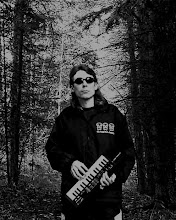
Where to start, on this milestone of an album? Preceded by the number one UK single "Cars" it propelled synthesizers to superstardom, along with their enigmatic but ultimately down-to-earth champion. On its heels New Wave was born, and the early 80's became an exciting time for music. This year -- indeed, this month -- marks the album's 30th anniversary, celebrated with a special edition of the album which includes all the b-sides, outtakes, and demos that could be rescued from the vaults.
My personal link with the album dates back to 1995. At the time I was living in my Uncle's house, and had access to his large collection of vinyl. Music-junkie that I am, I spent many hours immersed in old Genesis records, among others. I passed-up The Pleasure Principle several times, but finally gave in to the intriguing cover with its one-word song titles. At once I found it familiar and strange, and after several listens I realised I'd discovered the music I'd been searching for all my life. I'd been a fan of David Bowie's work -- particularly his synthier moments -- and several New Wave bands, but none of them had quite crystallized the precise mood of starkness and alienation that The Pleasure Principle conjured up. Needless to say, I played the album far more often than was healthy for those around me, and sat there in the isolation of a small Canadian town wondering if Mr. Numan had recorded anything more...
He had. Some fifteen albums at that time, not including live records, collaborations, and extraneous material. But I didn't discover that until those heady early days of the internet. In the meantime, I managed to get hold of a two-CD 'best of' compilation, which became one of the most-played albums I've ever owned, and some early LP's.
But back to the album at hand. There are no guitars on The Pleasure Principle (save for bass) and it struck me at the time as being a bold statement for a rock musician. Instead, there are layer after layer of powerful synthesizer parts set against a backdrop of Cedric Sharpley's funky drumming, the unique bass-work of the late Paul Gardiner, and some beautiful viola flourishes courtesy of Chris Payne. Ultravox keyboardist Billy Currie also lends his violin to a couple of tracks, and played keyboards in the live band during the subsequent tour. Numan's exceptionally unique voice is often double-tracked, a technique which excentuates the science-fiction feel of the music; like some Big Brother figure broadcasting over a P.A. system.
The principle synthesizer is the Moog Polymoog Keyboard, which came stock with the unique and powerful Vox Humana patch, which Numan used extensively both live and on albums during the period. There are far better sources of information on how Numan used the Polymoog, putting it through effects-boxes and so-forth, so I won't go into that here. Suffice to say that it's one of the most incredible synthesized sounds you are likely to hear. Also used on this album were the Moog Minimoog and ARP Odyssey.
As luck would have it, all ten tracks are playlisted on youtube, as well as the bonus tracks from the original reissue. This has spared me the agony of choosing highlights, when every song, to my mind, is integral to the listening experience. Without further ado:
Gary Numan - The Pleasure Principle (YouTube Playlist)
The album opens with "Airlane," an upbeat instrumental. Immediately the biting, tearing, and soaring synth tones are unleashed. Even though guitar is absent, there are synth parts played like powerchords to give the effect. "Metal" follows, with its driving rhythm and crashing percussion. Nine Inch Nails, and the hip-hop pioneer Afrika Bambaataa have both covered this song. Next is "Complex," which is almost the opposite - lilting and strangely beautiful, but at the same time as electric as standing next to a power station. The viola also makes its first appearance. This song is a personal favourite. "Films" cranks things up again. The drum beat was a favourite with rappers in the early 80's, and is still sampled from time to time. "M.E." is another personal favourite. Some of you might recognise the riff: it was borrowed by Basement Jaxx for their song "Where's Your Head At." The synthetic hand-claps on this track are created by the Simmons Clap-Trap, which can also be heard elsewhere on the album. I always think of "Tracks," "Observer," and "Conversation" as something of a trilogy. Not because of any overall theme, but because of how they fit so nicely together in order on the album. The first two are quite short, but by no means ordinary, while "Conversation" is something of an epic. Second-last, but not least, "Cars." Number one in Canada and the UK, and it even broke the charts in the U.S.A. Undoubtedly Numan's best-known song, and it's been covered and sampled by many artists, notably Fear Factory. I have to admit that I've heard it so many times that I often skip it these days, but there's no denying the outro is awfully good. Lastly, the quirky mechanical marching song "Engineers," closes the album.
I've often thought The Pleasure Principle has a lot in common with utopian/dystopian sci-fi films. Bright and happy at the beginning, until all too quickly the seething underbelly of corruption is revealed and our protagonist goes underground on a flight for his life. Until, despite his best efforts, he is thwarted by his gloating oppressors. Numan's lyrics are often highly metaphorical, and there are of course a million different ways you could interpret them; a million different images they might conjure up. Such is the brilliance of music, and the brilliance of this album. I hope you enjoy it.






